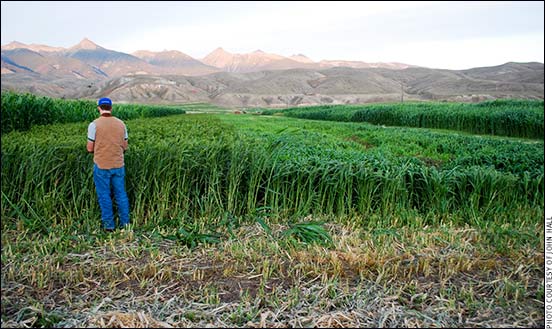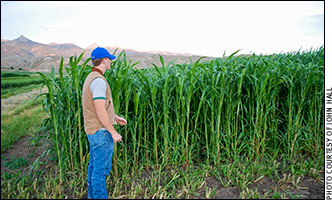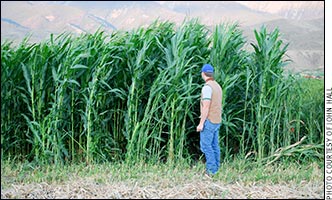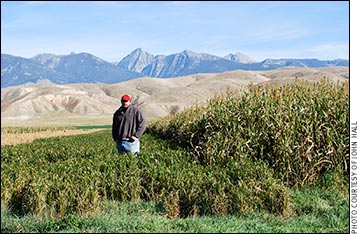
In 2008, the University of Idaho’s Nancy Cummings Research, Extension and Education Center in Salmon, Idaho, began looking at ways to extend grazing with summer annuals. The first test plots contained five species of warm-season annuals — Sudex, teff (an annual grass), German foxtail millet, pearl millet and grazing corn.
Extend Fall and Winter Grazing
Idaho researchers look to extend grazing with summer annuals.
In dry climates ranchers often run short on late-summer and fall pasture, especially when productivity of cool-season perennial grasses is limited during the heat of summer. In 2008, the University of Idaho’s Nancy Cummings Research, Extension and Education Center in Salmon, Idaho, began looking at ways to extend grazing with summer annuals.

“Since then we have just planted Sudex — the sorghum-Sudan hybrid — around the first of July,” John Hall, University of Idaho Extension beef specialist, says, “to provide grazing in November and December. The most productive year, we were able to graze 100 head for 40 days on 16 acres.”
John Hall, University of Idaho Extension beef specialist, says they looked at species that grow well in dry corners of pivot-irrigated ground to try to increase hay yield or pasture. It evolved into a project to increase forage production for fall grazing. The first test plots contained five species of warm-season annuals — Sudex, teff (an annual grass), German foxtail millet, pearl millet and grazing corn.
“Since then we have just planted Sudex — the sorghum-Sudan hybrid — around the first of July,” Hall says, “to provide grazing in November and December. The most productive year, we were able to graze 100 head for 40 days on 16 acres.”

The crop did well under irrigation with some fertilization, Hall reports, explaining they used 40-60 units of nitrogen per acre. “You don’t want to use very much,” Hall cautions, “because these plants are nitrate accumulators, and you don’t want nitrate toxicity problems.”
The crop did well under irrigation with some fertilization, Hall reports, explaining they used 40-60 units of nitrogen per acre.
“You don’t want to use very much,” Hall cautions, “because these plants are nitrate accumulators, and you don’t want nitrate toxicity problems.”
Generally, the researchers expect about 70-80 animal grazing days per acre, using strip-grazing. A rotary mower is used to make swaths for single-strand polywire fencing. Hall says they proportion how big an area to fence by the size of the cattle herd. Occasionally, the portion has been too big and a bit was wasted, or it was too small and fence needed to be moved more often, but he says the system works.

“When choosing a crop for fall grazing, we look at whether it will hold up under a snow load. That’s where some of the warm-season annuals like Sudex work well, because it’s always sticking up through the snow. There is no problem for cattle finding the plant, and once they find it, they root down and utilize it."
“We found that when we mow paths through the field, the cut plants thatch over the ground, protecting it from freezing as deeply when weather gets cold in the fall. It’s easier to put the temporary tread-in posts into the ground for our hot wire,” he explains. This crop doesn’t provide all the fall grazing needed for the university herd, but it does help extend the forage resources.
“When choosing a crop for fall grazing, we look at whether it will hold up under a snow load. That’s where some of the warm-season annuals like Sudex work well, because it’s always sticking up through the snow. There is no problem for cattle finding the plant, and once they find it, they root down and utilize it. Making big windrows also helps to graze that way; once they find the windrow, they’ll root through the snow to eat it,” he says.
One drawback with some annual crops is wildlife damage. Hall found that elk don’t damage the Sudex as much as some of the other crops during the growing season.
“I don’t know whether it’s a palatability issue, or the fact that Sudex can get up to 12 feet tall and they can’t see through it. By contrast, deer come in and make tunnels. Deer eat it, but don’t do near the damage to that crop that they did with the grazing corn. There wasn’t an ear that hadn’t been chewed during the three years we planted corn,” he says.

Editor’s Note: Heather Smith Thomas is a freelance writer and cattlewoman from Salmon, Idaho.





